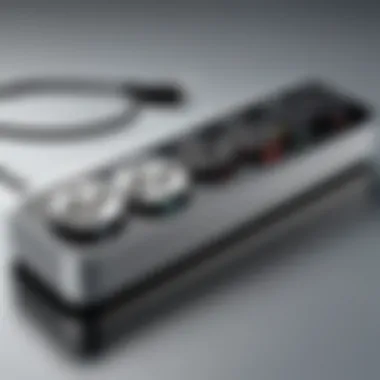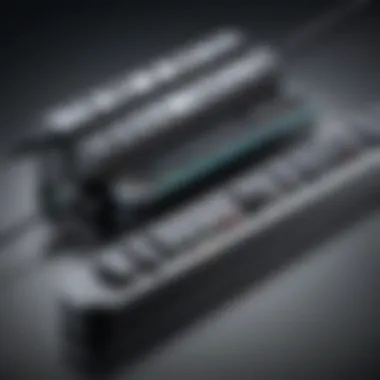Comprehensive Overview of Extra Large Power Strips


Intro
The reliance on electronic devices has escalated significantly in recent years. This creates a need for effective power distribution solutions. Extra large power strips embody this need, serving as essential tools in both professional and personal spaces. They cater to a variety of devices while ensuring safety and convenience. Understanding their design and functionality is crucial for IT professionals and tech enthusiasts alike. This section delves into product overview, performance analyses, and the broader implications of using extra large power strips.
Product Overview
Extra large power strips are designed to accommodate multiple devices simultaneously. Unlike standard power strips, they offer a greater number of outlets, making them highly effective for tech-savvy users who often manage various devices.
Key Features
Some key features set these power strips apart:
- Number of Outlets: A typical extra large power strip may offer between 10 to 12 outlets. This is essential for users with numerous devices.
- Surge Protection: Most power strips are built to protect against power surges, safeguarding connected devices.
- USB Ports: Many models include USB ports for convenient charging of mobile devices.
- Cord Length: A longer cord provides flexibility in placement while reducing clutter in workspaces.
Technical Specifications
Examining technical specifications helps in selecting the right power strip.
- Voltage Rating: Most strips typically handle 120 volts, suitable for standard devices.
- Amperage Capacity: The capacity usually ranges from 10 to 15 amps, allowing for significant power delivery.
- Compatibility: Extra large power strips may cater to various plug types.
In looking specifically at leading brands like Belkin and Anker, these specifications tend to be consistent. This consistency ensures that users have reliable power sources that can cater to their device needs over time.
Performance Analysis
To fully appreciate the value of extra large power strips, performance analysis is critical. This involves reviewing both benchmark tests and real-world usages.
Benchmark Test Results
In performance tests, extra large power strips demonstrated consistent power delivery. Many brands were evaluated for:
- Surge Protection: Test results showed that some models effectively absorbed surges, protecting devices connected against potential damage.
- Heat Dissipation: Ideal strips maintained lower temperatures during extended usage, indicating robust design.
Important: Good performance in both surge protection and heat dissipation is essential for device longevity.
Real-World Usage Scenarios
Considering real-world applications can provide deeper insight. Some common scenarios include:
- Office Environments: Here, many devices such as computers and printers may require simultaneous power. Extra large power strips keep workspaces organized.
- Home Entertainment Systems: Users often have multiple television accessories, gaming consoles, and streaming devices. Space-efficient power solutions help in managing these effectively.
- Event Settings: For presentations or exhibitions, having several laptops and projectors running may require strategic power distribution.
Foreword to Extra Large Power Strips
The growing reliance on multiple electronic devices in both professional and personal environments makes extra large power strips increasingly relevant. This article explores the various dimensions that define their utility, significance, and evolution in technological contexts.
Definition and Purpose
Extra large power strips are extended power distribution solutions that come with multiple outlets, designed to cater to a range of devices simultaneously. Unlike traditional power strips, these facilitate the connection of larger devices such as computers, printers, and other office equipment. Their primary purpose is to provide an organized means of power distribution, effectively accommodating many plugs without compromising safety and functionality. This aids in preventing clutter and maximizing accessibility in setups that demand a high volume of electrical connections.
Historical Context
In a world where devices are rapidly advancing, the landscape of power distribution has undergone significant changes. The inception of power strips dates back to the mid-twentieth century, primarily designed to address the scarcity of wall outlets. Over decades, extra large power strips evolved from rudimentary designs to sophisticated models featuring surge protection and USB ports. This evolution mirrors the broader transition toward technology-driven living and working spaces. As devices multiply, the need for efficient power management solutions became paramount, prompting manufacturers to innovate and enhance the functionality of power strips.
Key Features of Extra Large Power Strips
Understanding the key features of extra large power strips is crucial for both consumers and professionals alike. These products are designed not only to provide multiple power connections, but also to enhance usability and safety in various environments. Recognizing the essential elements contained in these devices can lead to better power management and device protection.
Number of Outlets
One of the defining elements of an extra large power strip is the number of outlets it provides. Unlike standard power strips, which might offer four to six outlets, extra large power strips can feature ten or more. This increased capacity supports the growing demand for power in homes and workplaces that rely on multiple devices.
Having numerous outlets is beneficial in reducing clutter from chargers and device cords. It allows users to plug in essential equipment like computers, printers, and monitors without compromising accessibility. Moreover, the arrangement of outlets often considers larger plugs, preventing obstruction among devices. This thoughtful design improves overall efficiency and ease of use.


Surge Protection Capabilities
Surge protection is another significant feature. Extra large power strips typically come equipped with built-in surge suppressors that protect sensitive electronics from voltage spikes. These surges can result from lightning strikes, power outages, or even faulty wiring.
The effectiveness of surge protection plays a critical role in safeguarding vital devices. A good power strip will protect against voltage spikes by redirecting excess voltage away from connected equipment. Users should look for models with a higher joule rating, as this indicates better protection against surges.
USB Charging Ports
With the increasing usage of smartphones, tablets, and other USB-driven devices, many extra large power strips integrate USB charging ports. This feature eliminates the need for additional chargers, helping to minimize wall clutter. USB ports are typically incompatible with traditional outlets, thus adding versatility to any workspace.
The added convenience of having USB ports allows users to charge devices directly from the power strip without sacrificing outlet space. This proves particularly useful in offices or homes where multiple devices are in constant need of power.
Power Rating and Current Load
Power rating is critical when selecting an extra large power strip. The power rating indicates how much current the strip can handle without overheating or failing. Devices connected to the power strip must not exceed this rating. It is essential for users to be aware of the combined wattage of all devices plugged into the strip.
Generally, most extra large power strips have a rating between 1,500 to 2,400 watts, making them suitable for most standard electronics. However, heavy equipment may necessitate a special rating, so always check specifications for compatibility.
Extra large power strips that have overload protection will automatically cut off power during an overload situation, adding another layer of safety for connected devices.
Key Point: Understanding the specifications of power strips ensures safe and effective usage for all electronic devices.
Material and Build Quality
The material and construction of extra large power strips are integral components that can influence their overall durability, performance, and user experience. Choosing a power strip made from the right materials can prevent safety hazards and enhance functionality, especially in situations with multiple devices drawing power simultaneously.
Plastic vs. Metal Enclosures
The choice between plastic and metal enclosures is critical in determining the user's needs. Plastic enclosures tend to be lighter and more portable. They are generally less expensive and versatile for various home or office environments. However, they may not offer the same level of protection against impacts, heat, or environmental factors as metal enclosures.
Metal enclosures, on the other hand, provide increased durability and strength. They can withstand harsher conditions, making them ideal for use in industrial or commercial settings. Furthermore, metal cases often have superior thermal management capabilities. This means they can dissipate heat more effectively, which is crucial in preventing overheating during prolonged use. Additionally, metal materials can offer enhanced EMI shielding, reducing interference from electronic devices.
When selecting between the two, consider the environment in which the power strip will be used.
- For home use: A plastic enclosure might suffice, especially if portability is key.
- For high-demand settings: A metal enclosure may be preferable for its sturdiness and enhanced safety features.
Cord Length and Flexibility
Cord length and flexibility are often overlooked yet vital aspects of power strips. A longer cord allows for more flexibility in placing devices, particularly in larger spaces such as offices or workshops. Users should aim for a cord length sufficient to reach distant outlets without being excessively long, as an overly long cord can lead to tangles and tripping hazards.
Flexibility of the cord often relates to its construction. STRONG cords tend to twist and bend more without damage, allowing for easier maneuvering. This characteristic is beneficial in dynamic environments where constant adjustments are necessary. A flexible cord reduces stress at connection points, which helps to maintain the integrity of the electrical connections over time.
In sum, both the material and build quality of extra large power strips are significant in ensuring reliability and safety. Users must carefully evaluate their specific needs and choose a product that balances durability, functionality, and user convenience.
Safety Standards and Certifications
Ensuring the safety of electrical devices is crucial, especially when dealing with extra large power strips. These devices often connect multiple appliances, which increases the risk of electrical failures or hazards. Recognizing the importance of safety standards and certifications protects both devices and users. The efficacy of power strips often hinges on their compliance with these regulations, presenting a compelling reason for users to understand the standards that influence their options.
UL Certification Importance
UL certification, or Underwriters Laboratories certification, offers assurance to consumers about the safety and performance of electrical devices. This certification process involves rigorous testing to ensure that products meet specific safety standards. For extra large power strips, having the UL mark signifies that the device can handle its rated voltage and current without hazards such as overheating or electrical fires.
The benefits are twofold: consumers receive peace of mind knowing their devices are tested, and manufacturers benefit from credibility and trust in their products. The mere presence of a UL certification can elevate a power strip’s perceived value. Therefore, when choosing a power strip, assess if it carries this certification.
Compliance with Regulatory Guidelines
Compliance with regulatory guidelines transcends mere certification. It represents adherence to safety laws established by government agencies. These regulations can vary by region but often include standards for energy consumption and safety features. Products like extra large power strips must meet these guidelines, ensuring they contribute to an overall safer electrical environment.
Some critical considerations here include:
- Energy Efficiency: Many countries have energy efficiency standards that products must meet to reduce waste.
- Fire Safety: Power strips need to comply with fire safety regulations that prevent overheating.
- Noise Levels: Certain guidelines address electromagnetic interference that could affect nearby devices.


Adhering to safety standards and regulatory guidelines is essential for ensuring that extra large power strips operate safely and efficiently.
The compliance aspect not only protects consumers but also holds manufacturers accountable. In a world increasingly reliant on power distribution solutions, ensuring products meet stringent safety measures is fundamental in fostering safe usage and innovation within the electronics domain.
Comparative Analysis of Leading Brands
Evaluating extra large power strips from various brands is crucial for users, particularly for IT professionals and tech enthusiasts. This analysis provides insight into the different features, performance metrics, and overall value each brand offers. By comparing leading brands, users can identify which options best meet their specific needs, whether for home offices, business settings, or educational institutions. This comparative approach allows for informed decision-making, ensuring that users invest in quality products that enhance their energy management and safety practices.
Brand A: Features and Performance
Brand A has positioned itself as a significant player in the power strip market. This brand is recognized for its durability and functional design. One of the standout features is its surge protection capabilities, which offer robust defense against voltage spikes.
- Number of Outlets: Brand A typically provides up to ten outlets, making it suitable for users with multiple devices.
- USB Charging Ports: Many models include USB ports, enabling the charging of phones and tablets directly from the strip.
- Power Rating and Current Load: Most products from Brand A support a high power rating, ensuring that all connected devices receive adequate energy without the risk of overheating.
Brand A's reliability and customer satisfaction ratings are generally high, reflecting positive user experiences.
Brand B: Features and Performance
Brand B is known for its innovative approach to power distribution. Users appreciate the smart features integrated into their power strips. This includes options for remote control via mobile apps and energy consumption tracking.
- Surge Protection: Like Brand A, Brand B boasts excellent surge protection, though it goes a step further with advanced filtering technologies that reduce electrical noise.
- Cord Length and Flexibility: Customers often highlight the flexibility of the cord's length, allowing for easier positioning in larger setups.
- Material Quality: Brand B uses superior materials, often metal for enclosures, which many users find aesthetically pleasing and more resilient.
Overall, Brand B appeals to tech-savvy individuals looking for enhanced functionality.
Brand C: Features and Performance
Brand C focuses on affordability while maintaining essential features. This brand caters mainly to budget-conscious consumers who still seek reliability.
- Number of Outlets: Typically, Brand C offers around six outlets, which is adequate for average household usage but may limit more tech-heavy setups.
- Basic Surge Protection: While the surge protection is decent, it is not as advanced as other brands. Users should consider this aspect if they are in areas prone to electrical surges.
- USB Ports: A few models have USB charging ports but fewer than those from brands A and B.
Brand C serves a niche of consumers looking for practical solutions without breaking the bank. Overall, while this brand may lack some features found in premium models, it offers reasonable performance for less demanding environments.
It is essential to analyze individual needs against the features offered by each brand to make a well-informed choice in selecting extra large power strips.
Applications in Various Environments
The relevance of extra large power strips significantly extends across diverse environments. Understanding their applications in distinct settings not only enhances your knowledge but helps in utilizing these devices optimally. Different environments have specific needs, and recognizing these considerations can lead to more effective power management and device safety.
Home Office
In a home office setting, the dependency on electronic devices is substantial. Extra large power strips provide multiple outlets, allowing users to connect computers, printers, and chargers conveniently. The surge protection features are especially important in a home environment where sensitive equipment is used. A sudden power surge can damage these devices, making it essential to invest in power strips that can safeguard against such risks.
Moreover, these power strips can often handle higher load capacities, suitable for equipment that might draw significant current. For individuals working with multiple monitors or high-performance computing devices, selecting a reliable power strip cannot be overstated. Also, with integrated USB ports in many models, charging devices like smartphones and tablets becomes easy. This can declutter the workspace and offer seamless connectivity.
Business Settings
In business settings, especially in offices with lots of technology in use, extra large power strips play a critical role. The necessity for multiple outlets readily accessible is crucial in conference rooms, break rooms, and workstations. They contribute to a practical arrangement, significantly reducing the clutter of cords and enhancing work efficiency.
Safety is a key concern in commercial environments. Thus, opting for high-quality power strips that comply with safety standards is mandatory. Businesses must select products that offer features such as overload protection and fire-resistance to ensure employee safety. In addition, energy management becomes easier with advanced power strips that include monitoring and control capabilities, helping businesses keep track of energy consumption.
Educational Institutions
Educational institutions benefit immensely from the use of extra large power strips. Classrooms, labs, and libraries are filled with electronic devices that require power. Here, these strips ensure that teachers and students can have the necessary equipment powered without the hassle of searching for available outlets. This promotes a more conducive learning environment.
Also, in lab settings, power strips are essential to managing multiple devices at once, from computers to various scientific equipment. With a focus on safety, purchasing power strips with appropriate certifications becomes essential for compliance with institutional safety guidelines. This reduces the risk of accidents caused by overloading outlets in an educational setting.
Investing in quality extra large power strips ensures safety and efficiency, particularly in environments where multiple devices are in use, whether at home, in businesses, or educational settings.
Impact on Energy Management
The role of power strips in energy management cannot be underestimated. Extra large power strips are valuable tools for both residential and commercial environments. They help in organizing multiple devices while also playing a significant part in the management of energy costs. Understanding how these strips contribute to energy management is critical for IT professionals and tech enthusiasts alike.


The core advantages of utilizing extra large power strips include:
- Centralized Control: Users can manage several devices from a single outlet.
- Energy Monitoring: Many modern power strips offer features that allow tracking of energy usage.
- Reduction of Standby Power: Power strips can help minimize phantom or standby power consumption by allowing quick disconnection of all devices with a single switch.
Energy Consumption Monitoring
Energy monitoring is a vital feature of extra large power strips. This capability is essential for detecting how much energy devices consume over time. Using a power strip equipped with monitoring capabilities can yield several advantages.
By keeping tabs on the energy consumption of household devices, users can identify which appliances are the most power-hungry. This data can inform decisions about upgrading equipment or utilizing devices during off-peak hours. For instance, a device that consumes high energy might be a prime candidate for replacement with a more energy-efficient model.
Moreover, insights gained from energy consumption monitoring can also lead to potential savings on energy bills. Understanding usage patterns allows for better scheduling of device usage and contributes to overall sustainable practices.
Enhanced Power Efficiency
Enhanced power efficiency is another aspect where extra large power strips excel. The design of these strips often accommodates features that promote efficient energy use. Such features include surge protection and individual outlet switches.
- Surge Protection: This protects devices from voltage spikes, thus ensuring longevity.
- Individual Outlet Switches: These allow users to power off devices that are not in use, further contributing to energy savings.
- Smart Technology Integration: Some power strips now incorporate smart technology, enabling remote control and automation via mobile apps. This enhances convenience and efficiency by allowing users to switch devices off remotely.
"Optimizing power usage with the right equipment can significantly reduce energy costs and environmental impact."
User Considerations and Recommendations
Understanding user needs is critical when choosing extra large power strips. Not only do these devices vary in features and capacities, but also in how they align with the specific requirements of the user. As technology evolves, it is essential to assess these considerations carefully, ensuring optimum functionality and safety.
Identifying User Needs
Every user has different needs based on their environment and usage. Recognizing these needs can significantly drive the decision-making process. For instance, a home office setup might require multiple devices connected simultaneously, such as computers, printers, and chargers. In contrast, a gaming setup may prioritize performance and fast charging capability.
When evaluating needs, consider the following factors:
- Device Types: Identify the gadgets that will be plugged into the power strip. Higher power consumption devices will require strips with substantial power ratings.
- Number of Outlets: Assess how many outlets are necessary. Extra large strips often come with ten or more outlets, suitable for tech-heavy environments.
- Surge Protection Requirements: In areas prone to electrical surges, invest in strips with robust surge protection features.
Being clear about requirements will lead users to make better-informed decisions that fit their unique scenarios.
Budgeting for Quality
While it may be tempting to choose a power strip based solely on price, investing in a quality product is crucial. A well-constructed power strip can prevent potential hazards such as overheating or fire while providing better performance.
When budgeting for a power strip, consider:
- Material Quality: Products made of durable materials like metal tend to offer better longevity compared to plastic variants.
- Surge Protection Ratings: Look for strips with reliable surge protection to safeguard your devices. Higher-rated models may come at a steeper price but are worth it in terms of reliability.
- Maintenance and Warranty: Evaluate whether the manufacturer offers a warranty. A solid warranty often assures better overall quality.
"Investing in a quality power strip is a proactive measure for safeguarding your devices against power fluctuations and potential damage."
By taking the time to clarify needs and budgeting appropriately, users can select power strips that best meet their requirements without sacrificing quality. This thoughtfulness in selection promotes enhanced performance, safety, and usability in various settings.
Future Trends in Power Distribution Technology
The landscape of power distribution is shifting due to technological advancements. Understanding future trends in power distribution technology is essential for IT professionals and tech enthusiasts. These trends will shape how we interact with power strips and electrical devices in homes and offices. One significant evolution is the emergence of smart power strips. These devices are equipped with intelligent features allowing users to monitor and control power usage more effectively. Enhanced functionalities cater to growing consumer demands for energy efficiency and convenience. The integration of various technologies not only improves user experience but also aligns with newer energy management solutions.
Smart Power Strips
Smart power strips represent a paradigm shift in energy distribution. Unlike traditional strips, smart variants have the capacity to connect to home Wi-Fi networks. This connectivity allows users to control their devices remotely via smartphone applications. They offer features such as energy monitoring, which helps users understand their consumption patterns.
Furthermore, many smart power strips come with built-in surge protection and automatic shut-off capabilities. These features enhance safety and longevity of connected devices. Users can schedule on/off times for various outlets to optimize energy use and reduce costs.
Here are some notable benefits of smart power strips:
- Remote Control: Managing devices from anywhere, using apps.
- Energy Efficiency: Monitoring and reducing excessive power usage.
- Enhanced Security: Automatic shut-off adds protection against surges.
- User-Friendly: Simple interfaces for easy operation.
Integration with IoT
The integration with IoT (Internet of Things) is another crucial aspect of future trends in power distribution. IoT technology facilitates seamless communication between devices over the internet. Power strips that integrate with IoT systems can interact with various smart devices around the home or office.
This connectivity enhances overall energy management. For example, when a user turns on a smart appliance, the power strip can adjust the load distribution accordingly, ensuring none of the devices experience overload.
Moreover, IoT-enabled power strips can provide data analytics to the user. This data helps in identifying usage patterns and optimizing performance based on individual needs.
To summarize, staying abreast of these trends is necessary for effective energy management and ensuring safety in modern settings. Both smart power strips and IoT integration promise to revolutionize how we think about power distribution in an increasingly connected world.



